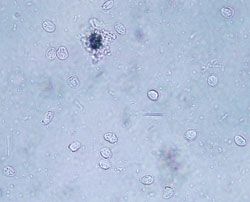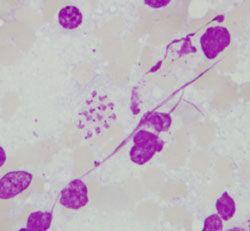ClinQuiz: Parasitology
Test your veterinary parasitology knowledge with this short interactive quiz.
ClinQuiz
1) Infections with the raccoon roundworm, Baylisascaris procyonis, have been increasingly identified in domestic dogs. These infections are of particular concern because:

Figure 1.
2)
A 12-week-old puppy is presented with a three-week history of intermittent mucoid diarrhea. The puppy has been treated with sulfadimethoxine for the last two weeks, but the diarrhea persists. Fecal flotation by centrifugation reveals these parasites (
Figure 1
). What is the most effective treatment protocol?
A. 50 mg/kg fenbendazole orally every 24 hours for five days
B. 25 mg/kg albendazole orally every 12 hours for two days
C. 30 mg/kg metronidazole orally every 12 hours for five days
3)
Numerous microfilariae, each about 6 or 7 µm wide and about 310 µm long, were found on a blood smear from a 2-month-old puppy from Alabama. The puppy's heartworm antigen test result was negative, and heartworm preventive therapy had not yet been started. How did this puppy most likely acquire this parasite?

Figure 2.
4)
A 5-year-old spayed female beagle is presented because of a progressively enlarging, nonhealing sore on its planum nasale. Treatment with a topical antibiotic ointment had not been effective. These organisms are found on a Giemsa-stained impression smear of the affected tissue (
Figure 2
). The history reveals that this dog traveled extensively in Italy and Spain several months ago. How did this dog most likely become infected with this parasite?
A. By inhaling infective cysts from the environment
B. From the bite of an infective sandfly
C. Through direct contact with an infected person
5)
A 9-year-old boy developed severe pruritus associated with erythematous and tortuous tracks on his feet, the back of his thighs, and both hands. The boy's pediatrician referred him to a dermatologist, who diagnosed cutaneous larva migrans and identified the pet dog, a 2-year-old bichon frise, as a potential source of the parasite. Diagnostic tests, treatment, and a review of the preventive program for what parasite, a causative agent of cutaneous larva migrans, are indicated in this dog?